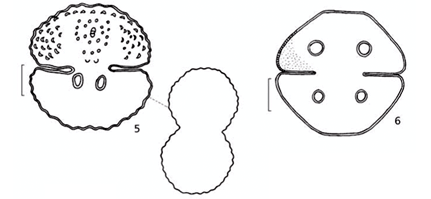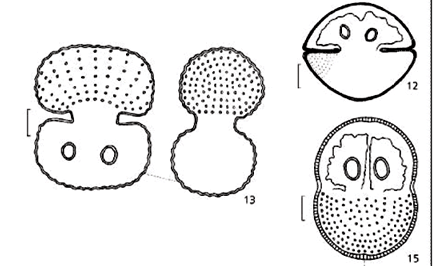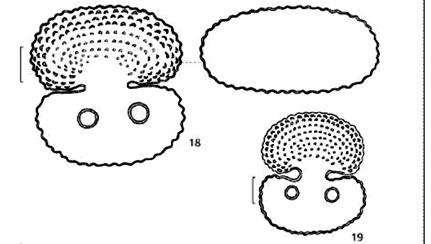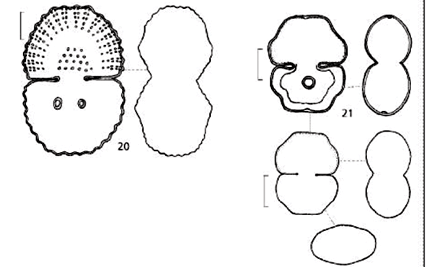Abstracts
With the objective of investigating the taxa of Cosmarium, four collection stations along the Corumbá Reservoir were set up. This resulted in the first work done on the genus in the State of Goiás. The collections of the material, of the epilithon type, were carried out in July 1996 and in the period between December 1996 and July 1997. The samples were preserved with 0.5% acetic lugol. The qualitative analysis was done by optical microscopic on non-permanent slides. Twenty-one taxa of the Cosmarium were described, each one illustrated by means of a camera lucida attachment.
Desmidiaceae; Cosmarium; reservoir; periphyton
Foram estabelecidas quatro estações de coleta com o objetivo de realizar um levantamento dos táxons do gênero Cosmarium no reservatório de Corumbá ao longo do sistema. Assim, este é o primeiro levantamento do gênero para o Estado de Goiás. As coletas do material, tipo epilíton, foram realizadas em julho de 1996 e no período de dezembro de 1996 a julho de 1997. As amostras foram preservadas com lugol acético 0,5%. Para análise qualitativa das amostras foram utilizadas lâminas temporárias com o auxílio de microscopia óptica. Ao todo, foram descritas 21 espécies de Cosmarium, sendo que para cada uma delas foram realizadas ilustrações em câmara clara e comentários taxonômicos, sempre que necessário.
Desmidiaceae; Cosmarium; reservatório; perifíton
Periphytic desmids in Corumbá Reservoir, Goiás, Brazil: genus Cosmarium Corda
Desmídias perifíticas do reservatório de Corumbá, Goiás, Brasil: gênero Cosmarium Corda
Felisberto, S. A.; Rodrigues, L.
Universidade Estadual de Maringá, NUPÉLIA, Av. Colombo, 5790, CEP 87020-900, Maringá, PR, Brazil
Correspondence Correspondence to Liliana Rodrigues Universidade Estadual de Maringá, NUPÉLIA Av. Colombo, 5790 CEP 87020-900, Maringá, PR, Brazil E-mail: lrodrigues@wnet.com.br
ABSTRACT
With the objective of investigating the taxa of Cosmarium, four collection stations along the Corumbá Reservoir were set up. This resulted in the first work done on the genus in the State of Goiás. The collections of the material, of the epilithon type, were carried out in July 1996 and in the period between December 1996 and July 1997. The samples were preserved with 0.5% acetic lugol. The qualitative analysis was done by optical microscopic on non-permanent slides. Twenty-one taxa of the Cosmarium were described, each one illustrated by means of a camera lucida attachment.
Key words: Desmidiaceae, Cosmarium, reservoir, periphyton.
RESUMO
Foram estabelecidas quatro estações de coleta com o objetivo de realizar um levantamento dos táxons do gênero Cosmarium no reservatório de Corumbá ao longo do sistema. Assim, este é o primeiro levantamento do gênero para o Estado de Goiás. As coletas do material, tipo epilíton, foram realizadas em julho de 1996 e no período de dezembro de 1996 a julho de 1997. As amostras foram preservadas com lugol acético 0,5%. Para análise qualitativa das amostras foram utilizadas lâminas temporárias com o auxílio de microscopia óptica. Ao todo, foram descritas 21 espécies de Cosmarium, sendo que para cada uma delas foram realizadas ilustrações em câmara clara e comentários taxonômicos, sempre que necessário.
Palavras-chave: Desmidiaceae, Cosmarium, reservatório, perifíton.
INTRODUCTION
The genus Cosmarium (family Desmidiaceae) is one of the largest of those belonging to Placoderm desmids. The characteristics of the specimens such as cell measurements, morphology, length/width relationship, open or shut sinus, amount of pyrenoids, wall forms and presence or not of granules, and lateral and apical view are important for identifying the species and the varieties of populations of Cosmarium.
In their heredity and evolution, many species of Cosmarium have demonstrated a considerable amount of instability in genetic composition. This has resulted in a sometimes confusing variability of morphological details (Prescott et al., 1981), because the genus is probably polyphyletic in origin and any grouping of species is artificial, and because its very numerous taxa are distinguished by ill-defined features (Croasdale & Flint, 1988).
This is the first work on taxonomic desmids, specifically of the genus Cosmarium, in the State of Goiás. Thus, the purpose of this work was to investigate the taxa of these species in the periphytic community of the Corumbá Reservoir, and to contribute to the understanding of the taxonomy and geographic distribution of desmids.
MATERIAL AND METHODS
Study area
The Corumbá Reservoir presents a 65 km2 flooded area of elongated shape and is located in the State of Goiás, having coordinates 17º59'S and 48º31'W (Fig. 1).
The collection stations were distributed along the reservoir, including its lotic, transitional, and lentic areas (Fig. 1).
METHODOLOGY
The collection of periphyton (defined as the community of microorganisms living on surfaces of objects submersed in water, in accordance with Wetzel, 1983), of the epilithon type (growing on hard, relatively inert substrata, such as gravel, pebbles, cobbles, and boulders, in accordance with Stevenson, 1996), was done in the littoral zone, in July 1996 (river phase) and in the period from December 1996 to July 1997 (reservoir phase).
The samples were conditioned in a 150 ml recipient, previously humidified with distilled water and placed in ice. In the laboratory, through scraping the substratum, the periphytic material was removed, fixed, and preserved with acetic lugol at 0.5%.
For qualitative analysis of the taxa belonging to the genus Cosmarium (preserved with 0.5% acetic lugol), an average of 10 non-permanent slides per sample were prepared and a 40 and 100X binocular microscope was used. The drawings were obtained through the Nikon 100X binocular microscope, with camera-lucida attachment. Taxonomic comments were made, whenever necessary. Thus, morphologic character descriptions and/or drawings were made only when analyzed by the microscope. Cell measurements (in mm) are indicated as follows: W = width, L = length, and a 10 mm scale is used for the figures are equivalent.
The taxons were identified according to Prescott et al. (1981), Förster (1982), Croasdale & Flint (1988), and Dillard (1991).
The samples are deposited in the herbarium of the Universidade Estadual de Maringá (HUM) numbering from 8054 to 8089, corresponding to the order in which the 36 samples were collected.
RESULTS AND DISCUSSION
A total of 21 species of Cosmarium were registered for the Desmidiaceae family. According to the taxa surveyed of desmids, Cosmarium was the most abundant genus. The second most common was Staurastrum, with 15 species (Felisberto & Rodrigues, 2002).
The genus Cosmarium is described as unicellar, having a constriction in the center and, depending on the species, is either wide and shallow or deep, open or closed; semicells, viewed apically, compressed, oval or elliptical; viewed laterally, mostly oval or elliptical, often with transverse swellings or protuberances; viewed frontally, semicircular, elliptical, reniform, pyramidal or quadrangular; viewed frontally, semicell margins smooth, undulate, granulate, dentate, serrate or with shallow depressions; cell wall smooth, punctate, granulate, scrobiculate, or dentate; chloroplast axial or parietal in each semicell; pyrenoids in each chloroplast (Prescott et al., 1981; Croasdale & Flint, 1988).
Family: Desmidiaceae
Genus: Cosmarium Corda ex Ralfs 1848
Key to species found:
1. Cell wall smooth or punctate: 2.
1. Cell wall granulate or crenulate: 12.
2. Margins undulate with 1 pyrenoid: Cosmarium naegelianum (Fig. 11).
2. Margins shaped otherwise: 3.
3. Semicells semicircular: 4.
3. Semicells shaped otherwise: 6.
4. Apical view circular: C. pseudoconnatum var. pseudoconnatum (Fig. 15).
4. Apical view elliptic: 5.
5. Semicells with a submamillate thickening: C. obsoletum var. obsoletum (Fig. 12).
5. Semicells without a submamillate thickening: C. baileyi var. baileyi (Fig. 3).
6. Semicells pentagonal: 7.
6. Semicells pyramidal: 9.
7. Semicells trilobed in frontal view with slight dilated apex: C. trilobulatum var. trilobulatum (Fig. 21).
7. Semicells shaped otherwise and straight apex: 8.
8. Face of semicells with projecting knoblike protuberances: C. regnellii var. regnellii (Fig. 17).
8. Face of semicells without this projecting: C. abbreviatum var. minus (Fig. 2).
9. Cells more than 39 mm long and chloroplast with 2 pyrenoids: C. galeritum var. borgei (Fig. 6).
9. Cell less than 39 mm and chloroplast with 1 pyrenoid: 10.
10. Semicells semicircular in lateral view: C. laeve var. laeve (Fig. 8).
10. Semicells elliptic to oval or elliptic in lateral view: 11.
11. Semicells elliptic in apical view; sinus deep and closed: C. granatum var. granatum (Fig. 7).
11. Semicells oval in apical view; sinus closed: C. laeve var. acervatum (Fig. 9).
12. Cell wall crenulate: 13.
12. Cell wall granulate: 14.
13. Semicells trapeziform in frontal view: C. formosulum (Fig. 5).
13. Semicells pyramidal-truncate in frontal view: C. subspeciosum var. subspeciosum (Fig. 20).
14. Isthmus elongated: C. portianum var. portianum (Fig. 13).
14. Isthmus not elongated: 15.
15. Semicells reniform: 16.
15. Semicells shaped otherwise: 17.
16. Semicells slightly compressed: C. reniforme var. reniforme (Fig. 18).
16. Semicells more compressed: C. reniforme var. compressum (Fig. 19).
17. Semicells with 1 pyrenoid: C. punctulatum var. punctulatum (Fig. 16).
17. Semicells with 2 pyrenoids: 18.
18. Frontal view pyramidal-truncate: C. vexatum (Fig. 22).
18. Frontal view elliptic-pyramidal: 19.
19. Margin of semicells with short spines: C. lagoense var. amoebum (Fig. 10).
19. Margin of semicells with granules: 20.
20. Sinus widely dilated at the apex: C. comissurale var. crassum (Fig. 4).
20. Sinus open at the isthmus or slightly closed in the area distal: C. protractum var. protractum (Fig. 14).
Cosmarium abbreviatum Raciborski var. minus (West & West) Krieger & Gerloff 1969 (Fig. 2).
Cells as wide as long or wider than long, 13.05-16.36 W, 13.05-16.36 L, 4.17-5.22 W at isthmus; median constriction deep, sinus closed; semicells transversely angular-oval with rounded lateral angles, truncate and straight apex; semicells oval viewed laterally and apically cell wall smooth; chloroplast with 1 pyrenoid.
Bicudo (1988) and Bicudo (1996) propose a synonymy list, due to extensive polymorphism verified for the taxon in samples from Ninféias Lake in the Fontes do Ipiranga State Park (São Paulo), and also for the material collected from the Corumbá Reservoir (Goiás). Identification proceeded as in Bicudo (1988) and Bicudo (1996).
Cosmarium baileyi Wolle 1884 var. baileyi (Fig. 3)
Cells wider than long, 39.15-60.0 W, 41.76-54 L, 11.4-23.49 W at isthmus; median constriction deep, sinus closed; semicells subsemicircular to trapezoidal, viewed frontally, with apex rounded to slightly truncate; semicells semicircular laterally viewed, apically viewed elliptic and inflated at the mid-region; cell wall punctate; chloroplast with 2 pyrenoids.
Cosmarium comissurale Brébisson ex Ralfs var. crassum Nordstedt 1870 (Fig. 4)
Cells as long as wide 34 W, 34 L, 10.15 W at isthmus; median constriction deep, sinus widely dilated at the apex; semicells elliptic-pyramidal in frontal view with produced and truncate apex; lateral and central extensions with variable granules variable; chloroplast with 2 pyrenoids.
This taxon presents a great morphological likeness with C. ornatum Ralfs. The identification differs with respect to the opening or not of the median sinus. C. ornatum presents sinus open at the isthmus and shut or slightly closed in the distal area, while C. comissulare var. crassum has an open sinus open throughout its extension. The ornamentation pattern of the cell wall is distinct for two species. This taxonomic approach was followed in this work.
Cosmarium formosulum (Hoff) Nordstedt 1888 (Fig. 5)
Cells 1.02 times longer than wide, 41.07 W, 42.14 L, 12.14 W at isthmus; median constriction deep, with sinus open (superficially) in throughout its extension; semicells trapezoidal to subsemicircular in frontal view, the basal angles rounded, the sides with 6-7 crenations; apex slightly truncate with 4-5 crenations; ornamentation in the whole cell, more concentrated in central and lateral part; cell wall granulate; chloroplast with 2 pyrenoids.
Cosmarium galeritum Nordstedt var. borgei Krieger & Gerloff 1962 (Fig. 6)
Cells 1.01-1.2 times longer than wide; 39.15-46.98 W, 41.76-46.98 L, 11.4-18.27 W at isthmus; median constriction deep, sinus closed; semicells pyramidal to trapezoidal with truncate apex, rounded basal and apical angles. Lateral view semicells semicircular and elliptic in apical view; cell wall punctate; chloroplast with 2 pyrenoids.
Cosmarium granatum Brébisson ex Ralfs 1848 var. granatum (Fig. 7)
Cells 1.3 times longer than wide, 26.10-30.01 W, 26.10-41.76 L, 7.83-10.44 W at isthmus; median constriction deep, sinus deep and closed, opening to the isthmus; semicells pyramidal with rounded basal angles and truncate apex; semicells in lateral view elliptic to oval, in apical view elliptic; cell wall variable, smooth but mostly finely punctate; chloroplast with 1 pyrenoid.
Cosmarium laeve Rabenhorst 1868 var. laeve (Fig. 8)
Cells 1.16-1.6 times longer than wide, 13.05-18.27 W, 18.27-29.71 L, 4.43-7.83 W at isthmus; median constriction deep, sinus closed and narrow; semicells variable in outline, mostly angulary pyramidal with rounded basal angles and rounded to slightly truncate in apex; semicells semicircular in lateral view and oblong to oval in apical view, sometimes slightly swollen; cell wall variable, mostly finely punctate, sometimes smooth; chloroplast with 1 pyrenoid.
Cosmarium laeve Rabenhorst var. acervatum Förster 1964 (Fig. 9)
Cells 1.19-1.4 times longer than wide, 16.0-26.10 W, 23.49-31.32 L, 5.22-7.83 W at isthmus; median constriction deep, sinus closed; semicells semielliptic to subpyramidal with truncate apex, basal angles broadly rounded; in lateral view elliptic and oval apical view; cell wall finely punctate; chloroplast with 1 pyrenoid.
Cosmarium lagoense Nordstedt var. amoebum Förster 1964 (Fig. 10)
Cells 1.04-1.14 times wider than long, 36.54-45.90 W, 32.62-43.27 L, excluding spines, 10.44-12.26 W at isthmus, spines with 2.61 L.; median constriction deep, sinus closed outwardly, apex open and oval shaped. Semicells elongate-oval with prominent apex and lateral lobes and apical margins ornamented with short spines; in lateral view semicells circular with short spines at the poles and granules at the margins; semicells with 3-lobed in apical view; chloroplast with 2 pyrenoids.
Cosmarium naegelianum Brébisson 1856 (Fig. 11)
Cells 1.06-1.22 times longer than wide, 18.27-25.05 W, 20.88-28.71 L, 4.95-7.83 W at isthmus; median constriction deep, sinus closed; semicells truncate-pyramidal with undulate margins; semicells subhexagonal in lateral view and elliptic-oval in apical view; cell wall punctate; chloroplast with 1 pyrenoid.
Cosmarium obsoletum (Hantzsch) Reinsch 1867 var. obsoletum (Fig. 12)
Cells 1.06 times wider than long, 44.37-56.11 W, 41.76-56.11 L, 13.05-23.49 W at isthmus; median constriction deep, sinus closed; semicells semicircular-pyramidal with a submamillate thickening; semicells in lateral view depressed globose, in apical view cell elliptic; cell wall punctate; chloroplast with 2 pyrenoids.
Cosmarium portianum Archer 1860 var. portianum (Fig. 13)
Cells 1.2 times longer than wide, 32.10-41.76 W, 40.71-52.20 L, 13.05-15.66 W at isthmus; median constriction deep and wide, sinus broadly open throughout extension; semicells slightly reniform to rectangular in frontal view; form oblong in lateral view and circular in apical view; cell wall homogeneously embellished with granules; chloroplast with 2 pyrenoids.
Cosmarium protractum (Nägeli) De Bary 1858 var. protractum (Fig. 14)
Cells about as wide as long or wider than long, 28.97-47.27 W, 28.71-44.37 L, 7.83-16.44 W at isthmus; median constriction deep with sinus open at the isthmus and shut or slightly closed in the area distal. Semicells 3-lobed with a subrectangular to subcircular form, with prominent and truncate apex and rounded margins with a granulated protrusion in the midregion; in lateral view semicell ovate, with a protuberance on each side near the base; in apical view cell elliptic to oblong; cell wall embellished with granules; chloroplast with 2 pyrenoids.
This taxon was identified to conform with Prescott et al. (1981), who distinguished C. protractum from C. ornatum. Thus, species with prominent apex in which an apical lobe is formed are assigned to C. protractum, whereas those with reniform or subreniform shapes, with apex only slightly elevated, are classified as C. ornatum.
Cosmarium pseudoconnatum Nordstedt 1870 var. pseudoconnatum (Fig. 15)
Cells 1.4 times longer than wide, 30.27-44.37 W, 36.54-60.03 L, 26.62-41.76 W at isthmus; median constriction very shallow, sinus very broad and shallow; in frontal view semicells semicircular, and circular in apical view; cell wall punctate; chloroplast parietal, 4 each semicell, each with 1 pyrenoid.
Cosmarium punctulatum Brébisson 1856 var. punctulatum (Fig. 16)
Cells 1.07-1.14 times longer than wide, or as long as wide, 16.96-20.88 W, 18.27-23.49 L, 5.22-9.13 W at isthmus; median constriction deep, sinus closed; semicells oblong to trapezoidal, margins undulates, rounded basal and apical angles and with truncate apex; semicells elliptic in apical view, and semicircular in lateral view; cell wall granulate; chloroplast with 1 pyrenoid.
Lopes (1992) mentioned the presence of prominent granules in the central area of the semicells, which were not observed. To Prescott et al. (1981), however, these granules are sometimes smaller and may occur in other areas.
Cosmarium regnellii Wille 1884 var. regnellii (Fig. 17)
Cells 1.2-1.5 times longer than wide, 10.44-13.20 W, 13.05-17.57 L, 5.22 W at isthmus; median constriction deep, sinus closed; semicells rectangular with angles extending as upwardly projecting knoblike protuberances in mid-region of lateral margins, below and above the retuse projection; truncate apex. Lateral view semicells subcircular and apical view oblong; cell wall smooth; chloroplast with 1 pyrenoid.
Cosmarium reniforme (Ralfs) Archer 1874 var. reniforme (Fig. 18)
Cells 1.03-1.4 times longer than wide, 32.10-44.37 W, 43.06-52.20 L, 10.44-15.66 W at isthmus; median constriction deep, sinus open to slightly closed outside; semicells reniform in frontal view and oblong lateral view; ornamentation in the whole cell; cell wall granulate; chloroplast with 2 pyrenoids.
Cosmarium reniforme (Ralfs) Archer var. compressum Nordstedt 1887 (Fig. 19)
Cells 1.1-1.2 times longer than wide, 38.33-46.3 W, 45.8-54.20 L, 10.83-12.1 W at isthmus; median constriction deep, with sinus widely open in isthmus to slightly closed outside (semicell half more closed); semicells reniform, but more compressed and with superior margins truncate; ornamentation in the whole cell; cell wall granulate; chloroplast with 2 pyrenoids.
Cosmarium subspeciosum Nordstedt 1875 var. subspeciosum (Fig. 20)
Cells 1.11-1.46 times longer than wide, and about as long as wide, 33.93-49.59 W, 49.59-55.2 L, 10.15-14.35 W at isthmus; median constriction deep, sinus narrow and closed throughout; semicells pyramidal-truncate, basal angles rounded, lateral margins with crenulations; in lateral view semicells quadrate, the apex truncate and granular; in apical view cell oval, the poles broadly rounded and with a conspicuous inflation in the mid-region on either side; chloroplast with 2 pyrenoids.
Cosmarium trilobulatum Reinsch 1867 var. trilobulatum (Fig. 21)
Cells 1.1-1.4 times longer than wide, 13.05-26.10 W, 18.27-31.32 L, 5.22-8.61 W at isthmus; median constriction deep, sinus closed; semicells subtrapizoidal and 3-lobed, with truncate basal lobes and apex, rectangular basal angles and apical slightly rounded; semicells elliptic in apical and lateral view, sometimes with slight thickness in midregion; cell wall smooth or finely punctate; chloroplast with 1 pyrenoid.
Cosmarium vexatum West 1892 (Fig. 22)
Cells 1.08-1.3 times longer than wide, 25.83-38.62 W, 30.01-43.40 L, 7.83-11.74 W at isthmus; median constriction deep, sinus open in isthmus only; semicells pyramidal with margins undulate and truncate; oval form in apical view and semicircular in lateral view with a slight protrusion in mid-region; cell wall with granules; chloroplast with 2 pyrenoids.
Acknowledgments The authors thank Dr. Carlos Eduardo M. Bicudo for taxonomic help; the biologists of Nupélia/UEM (Núcleo de Pesquisas em Limnologia, Ictiologia e Aqüicultura da Universidade Estadual de Maringá) for aid in collections; to Jaime Luiz Lopes Pereira for help in the drawings; CNPq (Conselho Nacional de Pesquisa), for the Scientific Initiation Scholarship; the referees for valuable suggestions on the manuscript; and Furnas Centrais Elétricas for logistic support.
Received March 21, 2002
Accepted April 28, 2003
Distributed February 29, 2004
(With 22 figures)
- BICUDO, C. E. M., 1988, Polymorphism in the Desmid Cosmarium abbreviatum var. minus (Zygnemaphyceae) and its taxonomic implications. Acta Bot. Bras., 2(1-2): 1-6.
- BICUDO, D. C., 1996, Algas epifíticas do Lago das Ninféas, Săo Paulo, Brasil, 4: Chlorophyceae, Oedogoniophyceae e Zygnemaphyceae. Rev. Brasil. Biol., 56(2): 345-374.
- CROASDALE, H. & FLINT, E. A., 1988, Flora of New Zealand: Freshwater algae Chlorophyta, Desmids Christchurch, New Zealand, 2. vol., 33 plates, 146p.
- DILLARD, G. E., 1991, Freshwater Algae of the Southeastern United States, part 4. Chlorophyceae: Zygnematales: Desmidiaceae (section 2). Bibl. Phycologica, 89: 1-205.
- FELISBERTO, S. A. & RODRIGUES, L., 2002, Desmidiales (exceto o gęnero Cosmarium) perifíticas, no reservatório de Corumbá, Estado de Goiás, Brasil. Iheringia série Bot., 57: 75-97.
- FÖRSTER, K., 1982, Conjugatophyceae: Zygnematales und Desmidiales (excl. Zygnemataceae). In: G. Huber-Pestalozzi (ed.), Das Phytoplankton des Süsswassers: systematik und biologie Stuttgart, Schweizerbart'sche Verlagsbuchhandlung, 543p.
- LOPES, M. R. M., 1992, Desmidioflórula do Lago Novo Andirá (Rio Acre), Estado do Amazonas Dissertaçăo de Mestrado, Instituto de Biocięncias da Universidade de Săo Paulo, SP, 166p.
- PRESCOTT, G. W., CROASDALE, H. T., VINYARD, W. C. & BICUDO, C. E. M., 1981, A Synopsis of North American Desmids; Part II. Desmidiaceae: Placodermae Univ. Nebraska Press, sec. 3, 720p.
- STEVENSON, R. J., 1996, An introduction to algal ecology in freshwater benthic habitats. In: R. J. Stevenson, M. L. Bothwell & R. L. Lowe (eds.), Algal ecology: freshwater benthic ecosystems Academic Press, New York.
- WETZEL, R. G., 1983, Recommendations for future research on periphyton. In: R. G. Wetzel (ed.), Periphyton of freshwater ecosystems Hague, W. Junk Publications (Developments in Hydrobiology, 17: 339-346).
Correspondence to
Publication Dates
-
Publication in this collection
25 Aug 2004 -
Date of issue
Feb 2004
History
-
Received
21 Mar 2002 -
Accepted
28 Mar 2003












